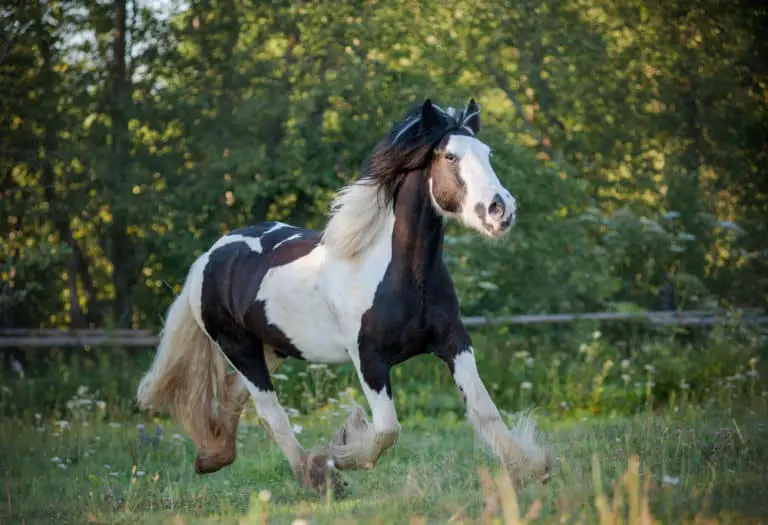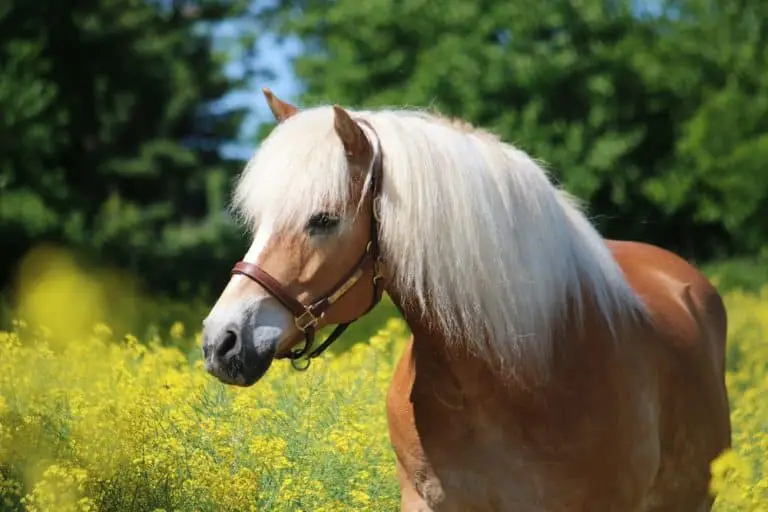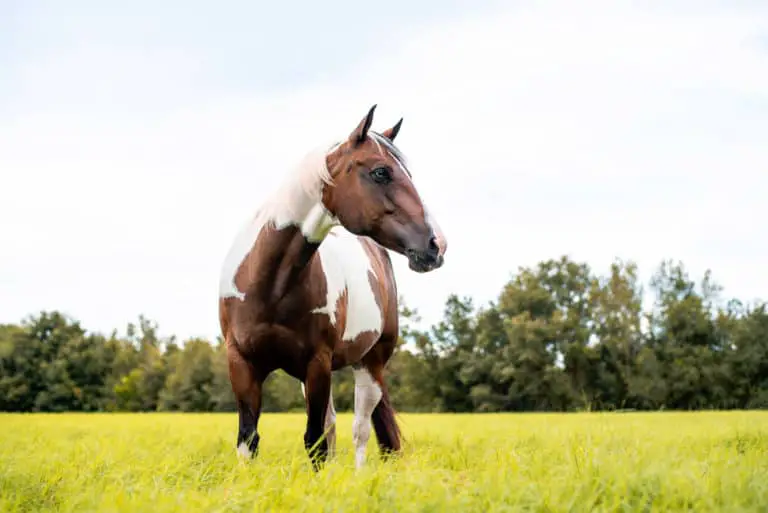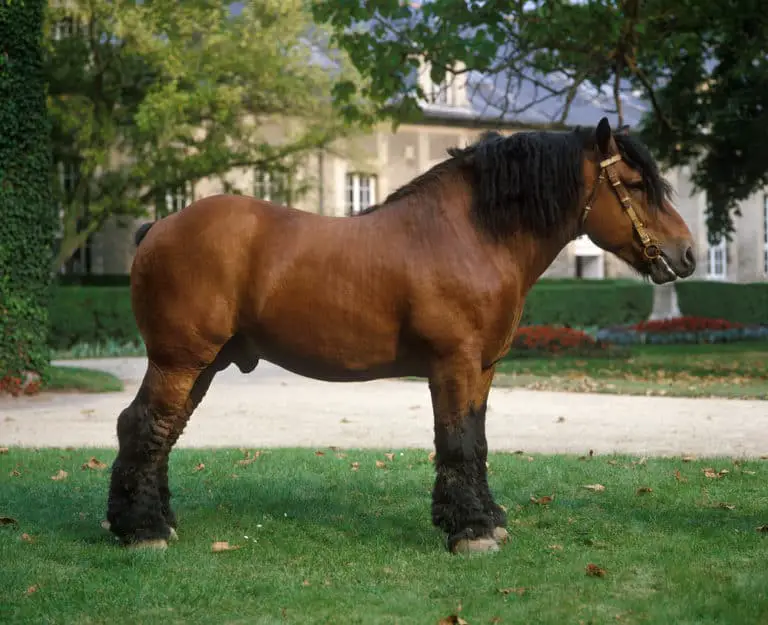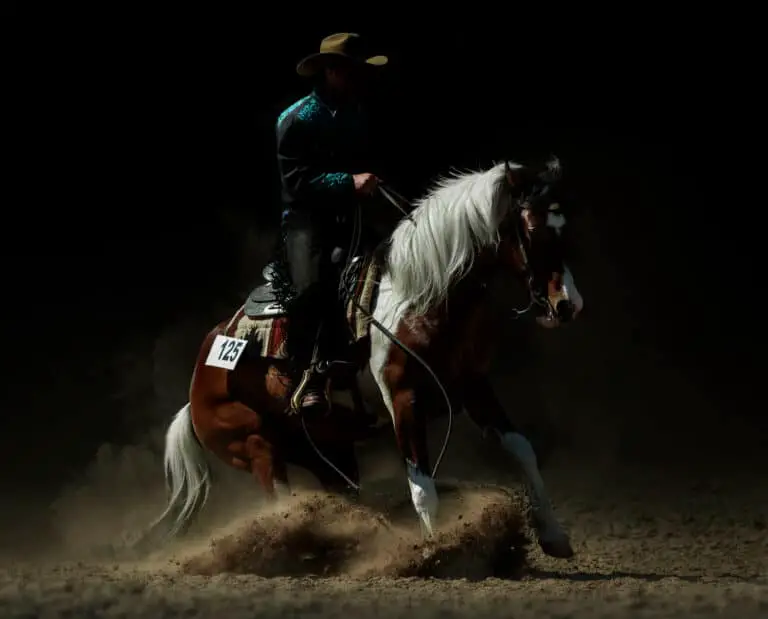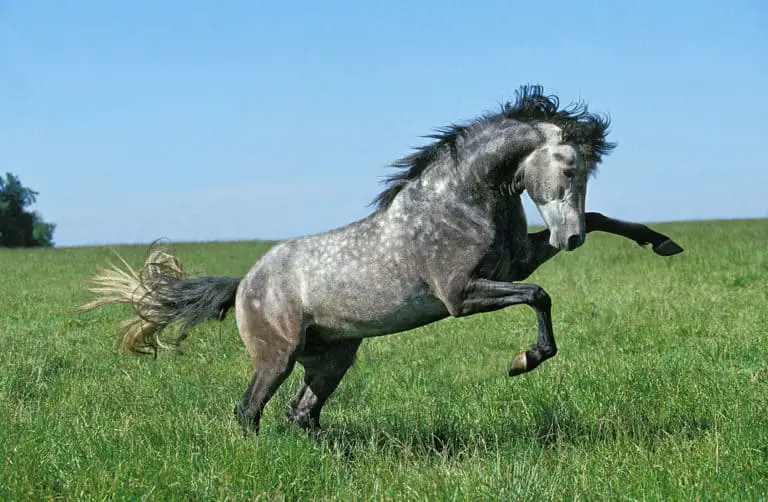Bashkir Horse Breed: Care, Cost & History (2025)
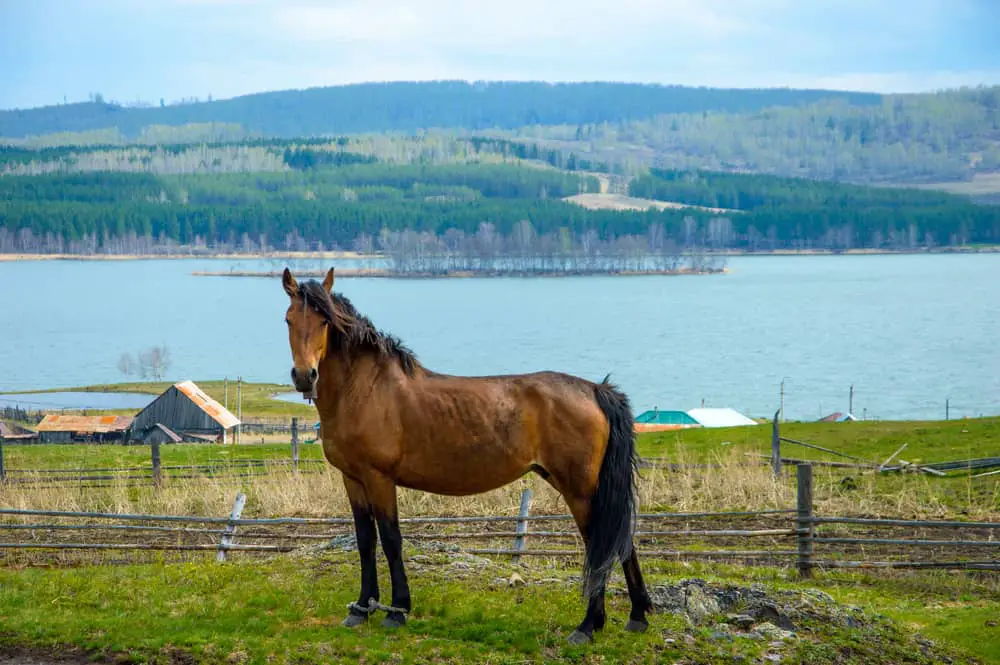
The Bashkir horse is a breed that developed under mysterious circumstances in southern Russia.
Although no one knows exactly where these horses came from, their incredible endurance, kind temperaments, and hardy characteristics have made them popular horses in the region.
They are also known for extremely high milk production and this milk produces kumis, a fermented dairy product.
Breed: Bashkir horse
Adult Weight: 800 pounds
Adult Height: 14 hands (56 inches)
Origin: Russia
Use: Draft, farm work, riding, milk production
Colors: Bay, chestnut, mouse gray, roan
Features: Wide body, large head, short neck, deep chest
Lifespan: 25 years
Character: Incredible endurance, intelligent, hardy
Gait: Sure-footed, lively gaits
Best for: All levels of riders
- Characteristics
- Bashkir Care
- Bashkir History
- Modern Bashkir
- Cost and Ownership
- Buying a Bashkir
- Similar Breeds
Bashkir Horse Characteristics
The Bashkir horse characteristics are distinct from other breeds. The Bashkir horse head is large with a wide, expressive eye, and it connects to a short neck. The chest is wide, the legs are strong and short. The back is short. They have a thick mane and tail and a curly coat. The horses are also kind and gentle.
Size
The Bashkir horse height averages 14 hands or 56 inches tall at the withers. (1) There are some members of the breed that are shorter and taller than this. Technically speaking, they are ponies, not horses. The males are slightly larger than the females.
The Bashkir size is often thought of as bigger because of the American Bashkir Curly, a distinct breed with a similar name. These are larger horses, but completely unrelated to the Bashkir horse of Russia.
The smaller height makes the Bashkir horse breed useful as pack horses, traversing challenging terrain, and riding horses. The smaller size must have been easier for milking the horses as well.
Weight
Bashkir horse weight averages 800 pounds per full-grown, adult horse. Again, there are members of the breed that weigh more and less, but across all horses, this is the typical weight. The males are generally heavier than the females.
The bone structure of the Bashkir breed is incredibly dense, especially in their sturdy legs. This bone density accounts for quite a bit of their weight.
A Bashkir foal will weigh about 10% of the mother’s weight at birth, so a typical foal is 80 pounds when born. They continue growing and reach about 50% of their adult weight – or 400 pounds – at six months old.
Colors
The beautiful Bashkir horse has four common colors, all augmented by its thick and flowing mane and tail. The Bashkir horse colors are bay, chestnut, mouse gray, and roan. Any others are rare Bashkir horse colors, given how many thousands of this breed there have been over history, and how predominant these main colors are.
One common misconception is that they are related to the American Bashkir Curly. The Bashkir horse of Russia can have curly hair, and it can be woven together when they shed out in the spring to make fabric. Although both breeds have the same hair, a two-year research project proved they are unrelated. (2)
Temperament
One of the best features is the Bashkir horse temperament. They are known as kind and gentle horses that are docile, yet with incredible endurance. This temperament makes them safe for beginner riders and children, and when traversing difficult terrain.
Bashkir horse behavior is also kind even when they are out in the large herds that used to exist in southern Russia. Their easygoing personalities made it possible for people to keep hundreds or thousands of horses.
The Bashkir horse is not common in the United States, therefore, they use the general rules of the United States Equestrian Federation. These state that children are not allowed to exhibit stallions. (3)
Bashkir Horse Care
The average Bashkir horse lifespan is 25 years, although these are hardy horses and some live longer than that. They are easy horses to care for because the breed developed in a challenging climate and since they have an easygoing temperament. However, they still require basic care in order to thrive.
Diet and Nutrition
The Bashkir diet can be kept fairly simple. These are hardy horses, and they do well on minimal amounts of feed. The horses lived outdoors with access to grass and other forage in the years of their early development in Russia.
They are small horses, so will eat less than other horses. The amount of nutrition required increases if they are in heavy work or used for milk production. (4)
They need access to quality forage, either hay or grass, to maintain their body weight and energy. Grass should not be overly rich, as it can cause health problems. Some horses may require grain or nutritional supplements as well. (5)
Health Problems
Healthwise, the Bashkir horse is a great choice. They were raised outside for hundreds of years in extreme temperature fluctuations and blizzards of snow. This developed them into a hardy horse breed.
A study on the economic benefits of horse production in the Bashkortostan region of Russia shows that the breed is an excellent choice, in part because they have very few genetic problems. (6)
If they receive the basic standards of care – access to freshwater, diet, nutrition, and regular veterinary and medical inspections – the horses will stay amazingly healthy. The biggest issues come from overfeeding horses a rich diet, and this can be prevented by carefully maintaining their diet and nutrition. (7)
Grooming
Daily Bashkir grooming is a good practice for any horse owner. First, it helps the horse and person bond with each other. Second, it allows you to check the horse for any injuries or health problems before they become too serious. This includes cleaning the hooves daily. Third, it helps keep their skin and hair in good condition. (8)
The mane and tail need special care because they are so thick. They should be carefully picked through to avoid breaking the hair. (9) Extra horse hair from the Bashkir was traditionally woven together for fabric, primarily when they shed out their winter coat. Although this may not be necessary anymore, you will notice plenty of hair during spring grooming!
Bashkir Horse History
The Bashkir horse history is a bit of a mystery, and that makes the breed all the more endearing. No one knows for sure where they came from, the horses that influenced the breed, or how they developed. But, the breed has been tracked and stewarded for the last several hundred years since they were discovered.
Origin
The Bashkir horse origin is in Bashkortostan, a republic in the southern region of Russia. The area includes mountains and steppes of the Ural and Volga mountains. The horses are named for the people – also called Bashkir.
The exact lineage of the horses or how they came to be in this area is unknown. One can imagine that l they developed over time from ancient ancestors, but we may never be exactly sure who these horses were.
Bashkir horses were bred for draft work, as pack horses, and for meat. They are also used for milk and are excellent producers, with the average mare having a 240-day lactation with about 4,600 pounds of milk total in that time.
Historic Development
Breeding and development of the Bashkir are concentrated in this region of Russia. Some believe, and the look of the horses lends itself to this theory, that they are a cross between Asiatic horses and those from northern regions. It’s also thought that they could descend from the Tarpan, a now-extinct horse.
At one time, there were 600,000 Bashkir horses in the region. Breeding centers were established in 1845 when the economic impacts of the horses were fully realized. Today, these centers are in Ufa.
Although their history is unclear, one has to guess that a colt usually became a Bashkir gelding and was used for pack and draft work and that the mares were highly prized.
Notable Bashkir Horses
The famous Bashkir horses are unfortunately referred to collectively in most cases, instead of by their individual names. But these horses still make a name for themselves and the focused breeding of the Bashkir horse pedigree has continued the breed and been used with other Russian horses. Most bloodline records are kept at the Ufa stud farm.
Horses of the Rebellion
Russia has controlled the Bashkir region for centuries. The people staged a rebellion from 1662 to 1664 to protest abuse and increasing taxes. The rebels fought hard, but ultimately, lost the rebellion. Their punishment was hanging in some cases, and horse confiscation in many cases. This was not the last time the horses were taken from the people.
The Honest Horse
We’ve always known that horses are smart, and in one legend from Russia, a Bashkir stallion killed a thief. Sultan Murat was the leading Bashkir thief and was living with the Kazakhs of the Middle Horde in 1739. He decided to travel to Urgench to trade goods, but the legend states that his horse killed him en route.
Fighting Napoleon
The Bashkir horses carried a group of soldiers from Moscow to France to fight Napoleon in 1812. After fighting, they then turned around and went back to Moscow. Their endurance is unprecedented among horse breeds, and it’s common for a team of three horses to pull a troika (similar to a sleigh) 75 to 90 miles in a day.
Myths and Legends
The Bashkir horse legends include their extreme hardiness, vast numbers owned by single families, and horses stolen by the government as retributions for acts of war. Each of these legends shows us how vital Bashkir horses were to the economic livelihoods of the people. The horses were used as a form of currency, transportation, and milk production.
Winter Warriors
The extreme weather conditions of the Ural mountain region have made the Bashkir horses into winter warriors. They are able to withstand driving blizzards and temperatures as cold as -40 degrees Celsius. The horses grow thick winter coats and live in large herds, but undoubtedly have some genetic characteristics that helped them adapt and survive too.
Symbol of Wealth
The Bashkir horse was a symbol of wealth for the people up to the mid to late 1800s. Most families had 20 to 30 horses of their own, while the wealthy Bahkir families would have up to 500 horses. The wealthiest of the Bashkir people had up to 2,000 horses on their own.
Stolen Horses
The Bashkir people revolted against the Russian government in the 1700s as part of the Russo-Bahskir Wars from 1735 to 1740. They lost, and one of the retributions was that horses and cattle were confiscated from them. Over 18,251 horses and cattle were confiscated during the Orenburg and Bashkir Commissions.
Modern Bashkir Horses
Today, there are two types of Bashkir horses. The mountain horse is smaller and more of a draft type, but can also be ridden. Bashkir horses bred on the steppes are taller and lighter and the more common saddle and harness horse. The breed is still incredibly popular in the Bashkir region, but rare outside this area.
Breeding
Bashkir breeding faces some challenges – notably that there are not a lot of people that specialize in the breed. So, most breeding farms are centralized in this one region of Russia, keeping the population contained there.
But, there are also very few people who know how to evaluate the Bashkir horses breeding, so it’s something that people in the region are organizing and working on.
Officials visited all the breeding farms, are identifying horses, and worked to preserve the breed and increase its popularity. As their population, uses, and popularity grows, the bloodlines will become better known and bred for.
Population
The Bashkir horse population is estimated at between 40,000 and 45,000 horses today. (10) This is down significantly from centuries ago, but is still a very healthy horse population. Furthermore, the rejuvenated interest in breeding and preserving the breed is assisting with numbers.
Currently, it’s believed that the entire population is located in Russia. There may be some Bashkir horses in Kazhakstan or other neighboring countries, but these are small numbers. Their traditional uses and the region’s isolation have limited any exports.
The large population in Russia means that they aren’t endangered though. Bashkir horses have the potential to be exported and enjoyed by other equestrians throughout the world.
Uses
The traditional Bashkir horse uses are draft work, riding, pack horses, harness, and milk production. But, an equestrian tournament, the Terra Bashkiria, was started in 2019. It features horse racing with Bashkirs and is increasing the breed’s popularity and making this a horse-breeding center.
Each year, the races become more competitive and popular. The officials are working with farms to breed horses and develop Bashkir horse training. The winning jockeys are young men, which means the future is bright.
The Bashkir horse gait has made them popular for centuries. Imagine riding from Moscow to France and back again. These are comfortable horses to ride! Some horses are gaited, and these are the fastest and most comfortable.
Bashkir Horse Prices
The Bashkir horse price is increasing, thanks to the Terra Bashkiria. There is an added layer of complexity to the cost of a Bashkir because the breed is only available in Russia right now. Additionally, there are other horse ownership costs besides buying the horse and getting it to your location, and those need to be considered too.
Purchase Price
The Bashkir is an expensive horse breed, not for the purchase price necessarily, but because of the complexities of buying one. This includes going to Russia to select a horse, and then the lengthy process needed to export a horse.
It currently costs between $2,500 and $5,000 for the purchase price of Bashkir horse. (6) But, the price is continuing to increase as the horses develop more uses. The racehorses and those winning or from winning bloodlines at Terra Bashkiria will be the most expensive. (11)
Other factors that will influence the price of a Bashkir horse are age, training if it’s a mare, and the bloodlines or how valuable that horse is to its current owner.
Ownership Costs
Ownership costs extend beyond the initial Bashkir price and the cost of transporting the horse. Horses need daily feed and care, as well as a place to live, just like us. The Bashkir horse cost of ownership is between $1,770 to $12,930 every year, for the entire time you own the horse, and these costs can’t be skipped.
Board
One of the biggest annual expenses is the Bashkir horse board cost. This is where your horse lives, and can be a stable, or pasture with a run-in shed. Since it’s a Bashkir, the cost can be on the lower end because they are a hardy breed. Budget for $1,200 and $7,200 a year. (12)
Feed
The next largest expense each year is the feed bill, which covers the horse’s diet and nutrition, and is the hay, grain, and supplements. The cost depends on your location, how much grass the horse has, and the level of work. Bashkir horse feed cost is anywhere from $250 to $4,380 a year. (12)
Veterinary Care
Annual veterinary care is essential, even for a hardy breed like the Bashkir. This includes vaccinations, dewormer, and dental care. A Bashkir in new locations will be exposed to diseases it may not have experienced before. Expect the Bashkir horse veterinary cost to be $250 to $350 each year. An illness or injury will increase the cost. (12)
Hoof Care
Identify a farrier who can trim the horse’s hooves every six to eight weeks, keeping the horse sound and healthy. The Bashkir horse hoof care cost is $120 to $1,000 annually; horses that need shoes cost more. Although the Bashkir has strong feet, consult with the farrier before making decisions on shoes. (12)
Buying a Bashkir Horse
The Bashkir breed is cool because they aren’t well known, but have so many talents to offer the world. Their feats of endurance are legendary, and anyone that enjoys spending long hours in the saddle should consider them. But, buying a lesser-known breed has some challenges too, so study up before making a final decision.
Is the Bashkir Horse Right for You?
The Bashkir horse is right for you if you’re in a colder climate, want a horse with a lot of endurance, and enjoy the challenge of finding and buying a horse that’s not widely available.
Riding a Bashkir horse, especially one of the gaited types, is smooth and comfortable. The horses have incredible stamina and can spend hours exploring new places with you. Bashkirs can also drive, either for pleasure or with draft-type work.
The gentle nature and easygoing personality of the breed make owning a Bashkir a possibility for anyone with the wherewithal to find the perfect horse, even beginners.
How to Buy a Bashkir Horse?
Buying a Bashkir horse may be a challenging process, but it’s definitely possible. Start by contacting a Bashkir breeder in southern Russia. Since the highest concentration of breeding horses are in the Ufa area, this is a good place to start.
Identify the type of riding you want to do and your goals for horse ownership. Share these with the breeder, and then try a few horses and determine if you’re a good match with the animal.
Although these are hardy and gentle horses, you should still pay attention and try several horses. One red flag to watch for is a horse that doesn’t want to leave its herd, or friends, as this is challenging to fix.
Similar Breeds to Bashkir
The Russian people have crossed all three of the Bashkir breed alternatives with the Bashkir horse. The Russian Heavy Draught is a workhorse that also has high milk production. The Kazakh horse is similar in size and used as a riding horse, while the Yakut developed extreme hardiness in Siberia.
Russian Heavy Draught
The Russian Heavy Draught horse was bred and developed for field and agricultural work. They are also incredible milk producers, like the Bashkir horse. They have a cob conformation and energetic, lively gaits that make them attractive to look at. Although the world wars decimated horse numbers, their population has grown since then and is steady now.
Kazakh
The Kazakh horse is similar in height and weight to the Bashkir horse and is used extensively for riding by the Kazakh people. Their geographic location includes Kazakhstan, Russia, China, Mongolia, and Uzbekistan. They are lighter horses with more finely developed bones than the Bashkir horse, largely due to the infusion of Thoroughbred and other bloodlines.
Yakut
The Yakut horse, also called the Yakutian, is native to Siberia and known for being incredibly hardy – it has to be to survive the harsh climate of Siberia. They are slightly smaller than the Bashkir horse and have incredibly thick hair, as well as having other adaptations to survive the climate. They are often used as pack horses.
FAQ
What is a Bashkir horse?
The Bashkir horse is a Russian horse breed whose origin is unknown but is popular for riding horses, for draft work, and as milk producers.
What does a Bashkir horse look like?
The Bashkir horse is small but sturdy, with a wide body, large bones, short back, and strong legs with an abundant mane and tail.
How did the Bashkir horse get its name?
The Bashkir horse is named for the Bashkir people and the region of southern Russia where the breed developed.
Can you ride a Bashkir horse?
Yes, you can ride a Bashkir horse; they have excellent endurance and are sure-footed.
Are Bashkir horses good for beginners?
Bashkir horses are good for beginners because they are docile with an even temperament, and intelligent horses.
How tall is a Bashkir horse?
The average height for a Bashkir horse is 14 hands or 56 inches.
How much does a Bashkir horse weigh?
The average weight for a Bashkir horse is 800 pounds.
How big is a Bashkir horse?
A Bashkir horse is not very big – by today’s standards, they are actually considered a pony size.
How much does a Bashkir horse cost?
A Bashkir horse can cost anywhere from $2,500 to $5,000, but the price will increase outside of Russia.
How much does Bashkir horse ownership cost?
Bashkir horse ownership costs between $1,770 to $12,930 each year.
How long do Bashkir horses live?
A Bashkir horse lives for around 25 years, although some live longer than that.
How fast can a Bashkir horse run?
The average Bashkir horse can run about 27 miles per hour.
How much can a Bashkir horse pull?
A Bashkir horse can pull around 1,200 pounds.
How much can a Bashkir horse carry?
Bashkir horses can carry up to 160 pounds.
At what age is a Bashkir horse full grown?
A Bashkir horse is fully grown at age four or five.
What are Bashkir horses used for?
Bashkir horses are used for many purposes, including riding, pack horses, draft work, and milk production.
References
- Alfa Horse. 2022. Bashkir Horse. Link
- Thomas, S, Cab Direct. 1990. The Curly Horse identification project of the CS fund conservancy (a case study). Link
- United States Equestrian Federation. 2022. Licensed Competitions. Link
- Nanaji Deshmukh Veterinary Science University. 2022. Feeding of Horses. Link
- Merck Vet Manual. 2021. Nutritional Requirements of Horses and Other Equids. Link
- Askarov A, Kuznetsova A, Gusmanov R, Askarova A, Kovshov V. Cost-effective horse breeding in the Republic of Bashkortostan, Russia. Vet World. 2020;13(10):2039-2045. Link
- Merck Vet Manual. 2021. Feeding Practices in Horses and Other Equids. Link
- Merck Vet Manual. 2016. Routine Health Care of Horses. Link
- United States Equestrian Federation. 2019. Pro Tip: Mane and Tail Care. Link
- Rupak Khadka. 2010. Global Horse Population with respect to Breeds and Risk Status. Link
- Realnoe Vremya. 2021. Will Bashkiria become center for development of horse breeding in Russia? Link
- Arabian Horse Association. 2022. What is the Cost of Providing for Them? Link

